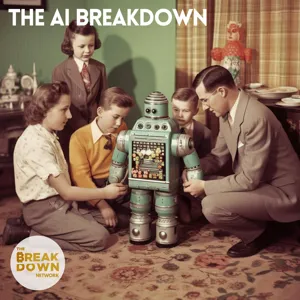Podcast Summary
Open Source AI Landscape: New Players and Ideas Emerging: Open source AI landscape is evolving rapidly with decreasing model training costs, new releases from Facebook, Tomorrow, and Stability, and continued VC funding driving the development of foundation models. Autonomous agents are a new trend in the model world for prioritization, reflection, and money-making capabilities.
The landscape of open source models in AI is rapidly evolving, with an increasing number of teams and individuals gaining the ability to train large models. OpenAI currently leads the pack, but the cost of training models is decreasing, and there are other notable releases from Facebook Llama, Tomorrow, and Stability. VC funding is expected to continue driving the development of foundation models, and it's predicted that a 3-5 level model will emerge within the open source ecosystem within a year. The ongoing trend is likely to be a handful of companies staying ahead of open source by one or two generations. A new and popular idea in the model world is the concept of autonomous agents, which involves orchestrating language models for prioritization, reflection, and money-making capabilities without changing the architecture of the language model itself.
Developing autonomous agents for complex tasks: Agents can analyze demand, find suppliers, set up shops, and promote ads, but remembering previous interactions and learning from them is a challenge for ongoing context. Regulation of AI is debated for protecting incumbents and addressing fears, but its impact on innovation should be considered.
The development of autonomous agents capable of completing complex tasks, such as setting up an online business, is an intriguing area of research in the AI community. These agents could analyze demand, find suppliers, set up shops, generate ads, and promote them on social media, all with a single high-level goal. However, the implementation of ongoing context for these agents, allowing them to remember previous interactions and learn from them, is a current challenge. This would enable the creation of a hive mind, where an AI system could remember and integrate the collective knowledge of all its interactions. Regulation of AI is a topic of ongoing debate, with some arguing that it could lock in incumbents and stifle innovation, while others express fears about potential risks. Ultimately, the reasons for regulation include protecting incumbents and addressing fears, but it's important to consider the potential consequences for innovation and progress in the field.
Focusing on specific areas of AI regulation: In the short term, it's crucial to focus on specific areas of AI regulation, such as export controls for advanced chip technology and limiting the use of AI for certain defense applications.
While there are valid concerns about the potential misuse of AI and its potential existential threats in the long run, it's important to remember that humans have a history of causing harm and accidents without technology's involvement. The doomsday predictions in the past have often been inaccurate, and it's crucial to consider people's actions rather than their words. In the short term, it might be more productive to focus on specific areas that require regulation, such as export controls for advanced chip technology and limiting the use of AI for certain defense applications. However, as we approach the 2024 election, the potential use of AI to influence elections or voting behavior could become a significant regulatory issue. Overall, it's essential to approach the regulation of AI with a clear understanding of both the potential risks and benefits and to consider the historical context of doomsday predictions.
AI's tactical and existential risks to humanity: AI's tactical risks include misuse leading to mass surveillance or lockdown, while existential risks involve AI surpassing human intelligence and becoming a threat to our species. It's crucial to distinguish between technology risk and species risk, and address challenges through democratic process and continued research.
The current advancements in AI technology pose both tactical and existential risks to humanity. The tactical risks involve potential misuse of AI, leading to mass surveillance or complete lockdown. The existential risks, on the other hand, are more profound and long-term, with the possibility of AI surpassing human intelligence and becoming a threat to our species. It's essential to distinguish between technology risk and species risk. Technology risk refers to potential harm caused by technology being abused, which can be mitigated by turning off servers or other measures. However, species risk is more significant and involves an existential threat to humanity, such as an AI developing a physical form and replacing humans in essential functions, leading to a loss of jobs and potentially even extinction. While the risks are significant, it's important to note that it's still early days in AI development, and there's time to address these challenges through a democratic process and continued research in areas like alignment and capability.
Identify game-changing opportunities within AI: Approach AI investing strategically, focusing on long-term potential and non-obvious applications
While the hype around AI investing is high, it's important to understand that not every investment will be successful. The speakers suggest that it's essential to identify the specific areas or opportunities within the AI wave that have the potential to be game-changers. They emphasize the importance of being the last company standing instead of the first to market. The speakers also mention that researcher-led foundation model companies are currently in high demand, but the applications of AI are likely to be non-obvious. They give the example of image generation from text, which was not an obvious use case a year or two ago. Overall, the key takeaway is to approach AI investing with a strategic mindset and focus on identifying the areas with the most potential for long-term success.
Exploring Voice Synthesis, Dubbing, and NLP in Audit, Tax, and Accounting: Significant cost savings and efficiency improvements can be achieved in audit, tax compliance, accounting reconciliation, and annotation through voice synthesis, dubbing, and NLP technologies. The potential applications are vast, and it will take several years to discover and build them all.
There are numerous exciting opportunities in the areas of voice synthesis and dubbing, and natural language understanding for audit, tax compliance, accounting reconciliation, and annotation. These areas have the potential for significant cost savings and efficiency improvements for businesses. The speaker is particularly interested in voice synthesis and dubbing infrastructure and applications, as well as compliance-related projects. They believe that there's a lot to be done in the entire stack, from infrastructure to tools, and that it will take several years for all the potential applications to be discovered and built. The speaker also expressed optimism about the potential for building defensible models and applications beyond being just a wrapper on existing large language models.
Role of foundation vs vertical-specific models in AI: The debate between foundation and vertical-specific models in AI continues, with advantages and disadvantages for each. OpenAI leads the field, but decreasing costs allow for more competitors. Regulation will play a significant role in shaping the industry's future.
The landscape of AI model development is rapidly evolving, with both established players and new entrants making significant strides. The debate surrounding the role of foundation models versus vertical-specific models is a topic of much discussion, with some arguing that vertical-specific models may offer advantages in terms of control and architectural differences. OpenAI is currently a leading player in the field, but the cost of training large models continues to decrease, making way for more competitors. The eventual distribution of market cap, revenue, employees, and innovation between incumbents and startups remains to be seen, but it's likely that both will continue to play important roles in the ecosystem. The regulatory environment will also be a crucial factor in shaping the industry's future. Elon Musk's recent actions, such as calling for a moratorium on AI progress while starting his own LLM company, have raised questions about incentives and potential conflicts of interest. Overall, the future of AI development is uncertain but full of promise and potential.
AI integration into business systems: Cost savings and industry disruption: AI integration into Salesforce and other business systems can lead to significant cost savings and operational efficiency gains, particularly in industries with complex integrations and high consulting fees. In healthcare, AI is expected to have a major impact on cost reduction and operational efficiency, but market access remains a challenge.
The integration of AI into existing business systems, such as Salesforce, could significantly reduce costs and time for businesses in various industries, particularly those with complex integrations and high consulting fees. This could make companies previously considered defensively fortified, like ERP providers, vulnerable to new approaches. Additionally, there may be opportunities for private equity firms to differentially bid on companies based on these cost savings. In the healthcare sector, the application of AI is expected to have a significant impact on operational efficiency and cost reduction, particularly in areas like healthcare delivery, telemedicine, and insurance reimbursement. However, market access remains a significant challenge in healthcare. Overall, the integration of AI into existing business systems and processes presents both opportunities and challenges, and requires a deep understanding of the specific industry and its unique complexities.
Regulatory hurdles and incumbent incentives in biopharma industry: Despite societal benefits, lengthy regulatory processes and incumbent incentives hinder new startups in biopharma industry, increasing costs and limiting access to new treatments
The high cost of drug development in the biopharma industry is not only due to the upfront research expenses but also the inefficiencies and regulatory hurdles that hinder new startups from entering the market. The speaker emphasizes the lengthy time it has taken for a new major biotech company to emerge, contrasting it with the tech industry's rapid growth. He also highlights the profitable nature of these companies, which creates strong incentives for incumbency. However, during exceptional circumstances like the COVID-19 pandemic, rapid progress was made by removing regulatory constraints. The speaker suggests that we need to consider the societal cost-benefit of adding more regulation, as it may slow down innovation, increase costs, and ultimately limit access to new treatments. In summary, the high cost of drug development in the biopharma industry is a complex issue driven by various factors, including regulatory hurdles and incumbent incentives.
Balancing regulation and innovation in different industries: In AI, prioritizing access to compute and government investment could lead to winning the technology race. In healthcare, investing in software related companies and leveraging LLMs offers opportunities despite regulatory challenges.
While reducing regulation and encouraging innovation are important for progress in various industries, there are instances where heavy government involvement can lead to significant advancements, as seen in the production of airplanes during World War 2. In the field of AI, ensuring access to compute and prioritizing it in the United States could lead to winning in this technology in a sustainable way. However, in healthcare, particularly in the pharmaceutical industry, there's a lack of generational companies due to various obstacles. Despite this, investing in software related companies that serve the healthcare infrastructure and leverage LLMs can lead to interesting opportunities. It's crucial to strike a balance between removing obstacles for innovation and safeguarding the public. Overall, it's an intriguing area with plenty of room for growth.





